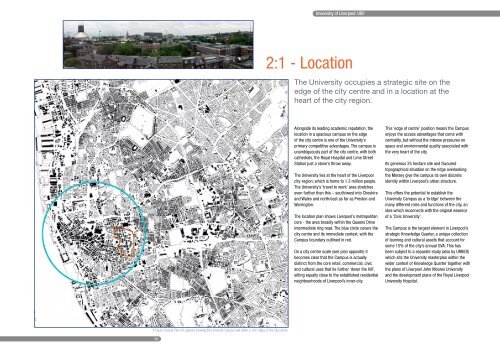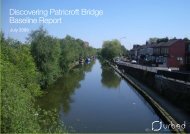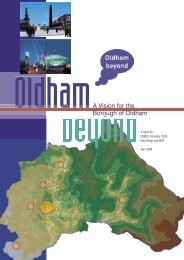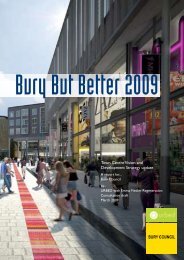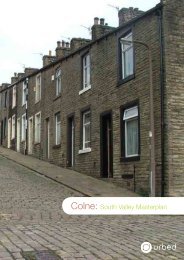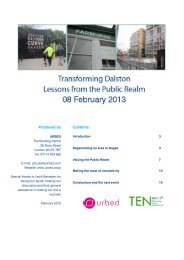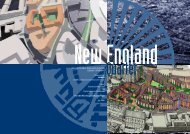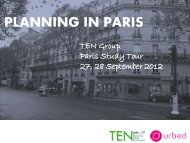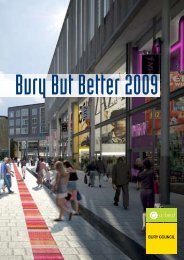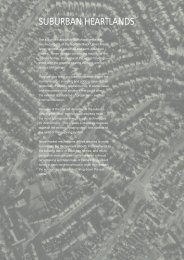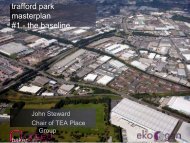URBAN DESIGN FRAMEWORK The University of Liverpool - Urbed
URBAN DESIGN FRAMEWORK The University of Liverpool - Urbed
URBAN DESIGN FRAMEWORK The University of Liverpool - Urbed
You also want an ePaper? Increase the reach of your titles
YUMPU automatically turns print PDFs into web optimized ePapers that Google loves.
<strong>University</strong> <strong>of</strong> <strong>Liverpool</strong>: UDF2:1 - Location<strong>The</strong> <strong>University</strong> occupies a strategic site on theedge <strong>of</strong> the city centre and in a location at theheart <strong>of</strong> the city region.Alongside its leading academic reputation, thelocation in a spacious campus on the edge<strong>of</strong> the city centre is one <strong>of</strong> the <strong>University</strong>’sprimary competitive advantages. <strong>The</strong> campus isunambiguously part <strong>of</strong> the city centre, with bothcathedrals, the Royal Hospital and Lime StreetStation just a stone’s throw away.<strong>The</strong> <strong>University</strong> lies at the heart <strong>of</strong> the <strong>Liverpool</strong>city-region, which is home to 1.3 million people.<strong>The</strong> <strong>University</strong>’s ‘travel to work’ area stretcheseven further than this – south/west into Cheshireand Wales and north/east as far as Preston andWarrington.<strong>The</strong> location plan shows <strong>Liverpool</strong>’s metropolitancore - the area broadly within the Queens Driveintermediate ring road. <strong>The</strong> blue circle covers thecity centre and its immediate context, with theCampus boundary outlined in red.On a city centre scale (see plan opposite) itbecomes clear that the Campus is actuallydistinct from the core retail, commercial, civicand cultural uses that lie further ‘down the hill’,sitting equally close to the established residentialneighbourhoods <strong>of</strong> <strong>Liverpool</strong>’s inner-city.This ‘edge <strong>of</strong> centre’ position means the Campusenjoys the access advantages that come withcentrality, but without the intense pressures onspace and environmental quality associated withthe very heart <strong>of</strong> the city.Its generous 25 hectare site and favouredtopographical situation on the ridge overlookingthe Mersey give the campus its own discreteidentity within <strong>Liverpool</strong>’s urban structure.This <strong>of</strong>fers the potential to establish the<strong>University</strong> Campus as a ‘bridge’ between themany different roles and functions <strong>of</strong> the city, anidea which reconnects with the original essence<strong>of</strong> a ‘Civic <strong>University</strong>’.<strong>The</strong> Campus is the largest element in <strong>Liverpool</strong>’sstrategic Knowledge Quarter, a unique collection<strong>of</strong> learning and cultural assets that account forsome 15% <strong>of</strong> the city’s annual GVA. This hasbeen subject to a separate study (also by URBED)which sits the <strong>University</strong> masterplan within thewider context <strong>of</strong> Knowledge Quarter together withthe plans <strong>of</strong> <strong>Liverpool</strong> John Moores <strong>University</strong>and the development plans <strong>of</strong> the Royal <strong>Liverpool</strong><strong>University</strong> Hospital.A Figure Ground Plan <strong>of</strong> <strong>Liverpool</strong> showing the <strong>University</strong> Campus well within a 1km radius <strong>of</strong> the city centre.10


